In a few years from now – maybe as soon as a year from now – we may look back upon the 2025 Honda Pilot very much as we look back on the V12 (and even V8) powered ultra-luxury vehicles of 20 years ago.
Because the Pilot comes standard with a V6 – and that’s getting to be a luxury. Even in luxury-brand (and priced) crossovers from BMW, Lexus and Mercedes – many of which come standard with fours.
And the Pilot comes standard with Honda’s excellent 3.5 liter V6 -one of the best engines of its type ever made.
It’s just a shame you can’t get it in an Accord anymore.
What It Is
The Pilot is a large crossover with three rows of seats that competes chiefly with the Kia Telluride (and its Hyundai Palisade fraternal twin) as well as the Mazda CX-90 and the Toyota Highlander, as well as the VW Atlas (which used to offer a V6 as an option but is now four cylinder-only).
Prices start at $40,200 for the base Sport trim with front-wheel-drive; AWD is a stand- alone option that bumps the MSRP up to $42,300.
There are also EX-L ($43,500 to start), Touring ($47,500 to start), TrailSport ($49,400) Elite ($53,080) and the top-of-the-line Black Edition ($54,580). The latter three all come standard with AWD. All trims except the TrailSport come standard with 20 inch wheels; the TrailSport has a unique-to-this trim 18 inch wheel/tire package with 265/60-18 all terrain tires for additional grip on gravel/dirt roads. This variant of the Pilot also gets a full-size spare, skid plates and an off-road tuned suspension with additional one inch of ground clearance (8.3 inches vs. 7.3 inches) and a standard Class III trailer hitch.
The TrailSport is also rated to pull up to 5,000 lbs.
What’s New For 2025
The Black Edition is a new addition to the Pilot lineup. This variant includes all the features that come standard in the Elite – including a 10.2 inch digital main instrument cluster, a Heads Up Display, a 12 speaker Bose stereo system, heated and ventilated seats, heated steering wheel and surround-view camera system plus special 20-inch gloss black wheels and black accent trim inside and out.
What’s Good
Standard V6.
TrailSport variant turns this crossover into an almost-SUV.
Likely lower depreciation than some of the others in the class.
What’s Not So Good
Kia Telluride – which also comes standard with a V6 – costs thousands less to start and has a roomier third row.
Standard trim is only rated to pull 3,500 lbs.
As is the case in all new vehicles – not just crossovers – pushy “driver assistance technology” is standard.
Every Pilot comes standard with Honda’s excellent 3.5 liter V6 – which Honda used to offer in the Accord sedan. Arguably, one of the reasons the Accord isn’t as hot-selling as it once was has to do with the fact that it’s no longer available with this powerful, durable engine that does not need a turbo to make power.
The question naturally arises: Why doesn’t Honda offer the V6 in the Accord anymore? Ironically, it is due to the fact that the Accord used to be a hotter-seller, which causes problems for Honda in terms of regulatory compliance costs. Specifically, Corporate Average Fuel Economy (CAFE) costs – in the form of fines imposed on vehicle manufacturers when they sell too many V6s, because these lower the manufacturer’s “fleet average” mileage numbers. This creates an incentive to sell fewer models with sixes rather than fours. Honda sells fewer Pilots relative to Accords, so it can still “get away” with offering Pilots with V6s. But probably for not much longer – because the government continues to ratchet up the mandatory MPG minimums, which makes it harder to offer sixes in anything that is not a low-volume, high-priced vehicle.
But – for now – the Pilot still comes standard with a six. It touts 285 horsepower and is paired with a 10 speed automatic, which has multiple overdrive gears designed to increase fuel economy by lowering engine speed to a fast idle once you’ve reached highway speeds. Front-drive models tout 19 city, 27 highway. With AWD, that goes down – just slightly – to 19 city, 25 highway.
Front-drive models are rated to tow 3,500 lbs., which is less than 5,000 lb. standard towing capacity of the Kia Telluride/Hyundai Palisade twins and the VW Atlas, even though the latter comes standard with a 2.0 liter four cylinder engine.
AWD-equipped Pilots come standard with a 5,000 lb. tow rating but this capability adds considerably to the price because you have to buy the AWD system to get it.
The Pilot accelerates briskly – zero to 60 in about 7 seconds flat – which is slightly quicker-accelerating than the also-V6-powered Kia Telluride and the four cylinder-powered VW Atlas, both of which take closer to 8 seconds. The Mazda CX90 is quicker than all of them and it has the only in-line six cylinder of the bunch, which is something you generally have to move up to something like a Mercedes to get. But the Mazda’s six is paired with hybrid system that greatly adds to the complexity of the powertrain and increases the potential for problems down the road due to the greater number of potential failure points.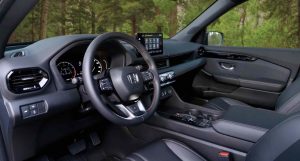
As an interesting aside, despite what you’d think would be the fuel-efficiency advantage of its hybrid powertrain, the Mazda’s touted gas mileage – 24 city, 28 highway – is slightly less than the Honda’s.
It is not exciting to drive the Pilot – but it’s not meant to be. Honda sells a lot of Pilots because they are easygoing, reliable family haulers and the 3.5 liter V6 is at the heart of all of that. In the Accord, this same engine was known to be a 250,000-mile engine. It’s a safe bet engine, in other words. It also has the right sound and feels right. Small fours in big crossovers like the Atlas (and Highlander) don’t. Some of these fours have to be “augmented” – by piping fake sounds of larger engines through the audio system into the cabin, to make you think you’ve got more than you’re packing.
And that’s kind of depressing.
The ten speed automatic is a good companion, too. Though it does have a lot of gears it does not feel or sound as though it is constantly shifting through them. The push button gear selector’s similar to what you’ll find in other Honda models (including the Accord) and while some may prefer a traditional-style lever that moves from front to back to engage Reverse, Drive and back to Park you’re not really (physically) engaging anything.
It’s all drive-by-wire, whether it’s buttons or levers.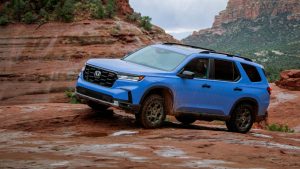
Honda did not go all-in with touchscreen controls for everything. You can adjust the AC and heat and fan settings without tapping/swiping anything. Just turn the knob to the left or the right. Same goes for the volume control. There’s a knob on the touchscreen for that. And there are buttons to turn on the seat heaters and the heated steering wheel.
In other words, you can just drive the Pilot – without having to futz with over-elaborate controls while you’re trying to drive. That’s especially helpful when you’ve got a bunch of kids in back trying to distract you.
The Pilot’s secondary controls do not add to those distractions.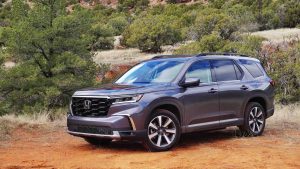
At The Curb
The Pilot is full-size, but not huge – as many SUVs with three rows and seating capacity for 7-8 people generally are. The Chevy Tahoe, for instance, is 211.3 inches long – or about a foot longer than the Pilot (which is 199.9 inches long). The extra foot does give a full-size SUV like the Tahoe more cargo-carrying room but both it and the Pilot have comparable room for people – and a full-size crossover like the Pilot will leave more room in your garage for things besides itself.
There’s still a lot of room for cargo, too.
The Pilot has 18.6 cubic feet of open space behind the third row and with the second and third rows down, the space opens up to 87 cubic feet. This is bit more space for cargo than the Mazda CX-90 has (14.9 cubic feet behind its third row and 74.2 with its second and third rows down and just slightly less than you’ll find in the Kia Telluride/Hyundai Palisade (which have 21 cubic feet behind their third rows and max out at 87 cubic feet).
As mentioned above, the Pilot comes standard with an unusually small (for a 2025 model vehicle) 7 inch LCD touchscreen, which is a plus if you’re a person who does not want a huge LCD touchscreen. Or all tap/swipe controls for the vehicle’s climate controls and entertainment systems. And if you do want the larger screen, it’s available in the higher trims – which is nice – because that means you’re free to choose it or not.
The Trailsport version of the Pilot offers most of the real-world-driving capabilities of an SUV without the SUV – which is a plus if you’re wanting a large family hauler that doesn’t feel as ponderous as a family-hauler SUV. Being a crossover, the Trailsport does not have a two-speed transfer case and 4WD Low range gearing, but it does have additional ground clearance and skid plates and all-terrain tires and that – plus AWD – will generally get you up any dirt road that isn’t just a rutted path through the woods – and that’s enough for many.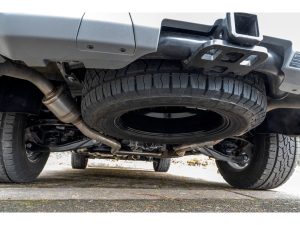
It also has a real (full-size) spare tire.
Other Pilot trims come with one of those “space saver” mini spares that will let you get back on the road if you get a flat – but only for short distances and at low speeds (you’re not supposed to drive on these at speeds much higher than 50 MPH). Space saver tires are smaller and lighter and so free up up storage space vs. a full-sized spare. The Trailsport has a full-size spare because you may need one if you have a flat far from a tire store – and because those mini-spares aren’t designed for off-road use.
Honda refers to the Pilot as an “SUV”- and the current model looks more like one than a crossover, which the last generation did. But it’s still a crossover – not an SUV. What’s the difference? Crossovers are based on lighter-duty, car-type underthings and usually have front-drive-based powertrains, with AWD available and sometimes standard. SUVs are usually based on heavier-duty, truck-type underthings and usually have rear-wheel-drive-based powertrains, with 4WD (and Low range gearing) available.
Does it matter? Only if you need heavier duty – including the capacity to pull more than 5,000 lbs. – and the ability to go seriously off-road, where you might need 4WD Low range gearing. If not, a crossover like the Pilot will give you on-road traction comparable to what you’d get with an SUV, enough towing capability to pull a small camper and just enough off-road capability to allow you to drive up dirt/gravel roads without getting stuck or damaging something underside the vehicle.
The Bottom Line
The Pilot has no major vices – and that is its main virtue.
. . .
If you like what you’ve found here please consider supporting EPautos.
We depend on you to keep the wheels turning!
Our donate button is here.
If you prefer not to use PayPal, our mailing address is:
EPautos
721 Hummingbird Lane SE
Copper Hill, VA 24079
PS: Get an EPautos magnet or sticker or coaster in return for a $20 or more one-time donation or a $10 or more monthly recurring donation. (Please be sure to tell us you want a magnet or sticker or coaster – and also, provide an address, so we know where to mail the thing!)
If you like items like the Baaaaaa! baseball cap pictured below, you can find that and more at the EPautos store!




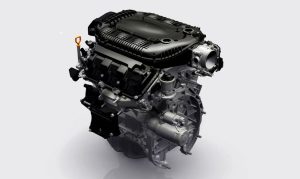
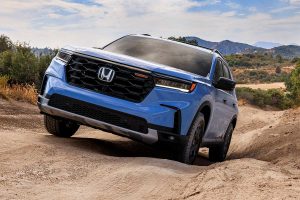
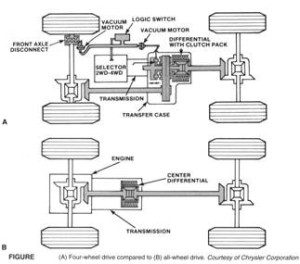

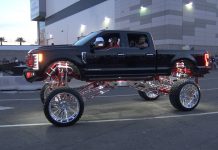

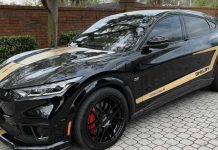

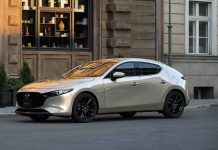


“Optional” engines for just about every non-truck have been dwindling recently.
Regulators have successfully worked with OEMs to limit options and streamline production and costs for decades now.
Looks to me like the buying public was ground down to accept it.
Even the mighty (dearly departed) 2GR V6 in the 8th gen Camry only had a 6% take rate. (It’s assumed the Accord had a similar ratio as a V6 Accord sighting is equally rare.)
Presumably when said bean counters run the numbers, does it make sense to not just sell everything AS the other 94%?
Stupid JIT supply chain and a dying US fiat dollar ruins everything.
Godspeed J35. May you continue to live on in the Pilot, Ridgeline, Odyssey and Passport for a long time.
‘The Pilot has no major vices – and that is its main virtue.’ — eric
Job #1 for me when investigating a new vehicle is to look up its weight.
The 2025 Honda TrailSport AWD weighs 4,685 lbs.
Like the average American, the TrailSport is morbidly obese.
I don’t need no fat-ass car.
I’ve owned an EX-L with 4wd since new, for over 20 years and 260K miles…
It’s probably the best vehicle expenditure/investment I’ll ever make, as it’s still running like new, mechanically, and no rust, either.
The Swiss army knife of SUV/CUV’s…..
Me too, a 2011 with 205,000 miles. Looks and drives like brand new except for some minor wear and tear.
Looks cramped for the driver. At 6’ 1” my long legs don’t do well with a giant center console, that raised edge looks like a leg smacker, annoying. My 2018 Grand Cherokee at least sculpts the dash into console no raised edges.
GC is code for POS in several other areas though.
While this wouldn’t fit a need for me, if one is to spend $40k (which is about average price now), Honda is generally reliable and a real V6 is an upgrade. I see lots of older ones still out there.
The Pilot is a very nice car. A little pricey to start but what isn’t these days. The Pilot is rated at 19 city and 27 highway for the two wheel drive and 19, 25 for all wheel drive, not bad for a six.
Itz a good time to shop for a low mileage Accord with the six. The exhaust could be modified with quad outlets to produce less back pressure and produce a Maserati style burble. De-badged it would be an Audi, BMW killer.
The other day a saw a newer black de-badged Chevy Malibu with quad exhaust outlets. It looked super. Chevy is run by bean counters looking to enrich the executives and they could care less about car nuts. There is always the aftermarket for a cure.